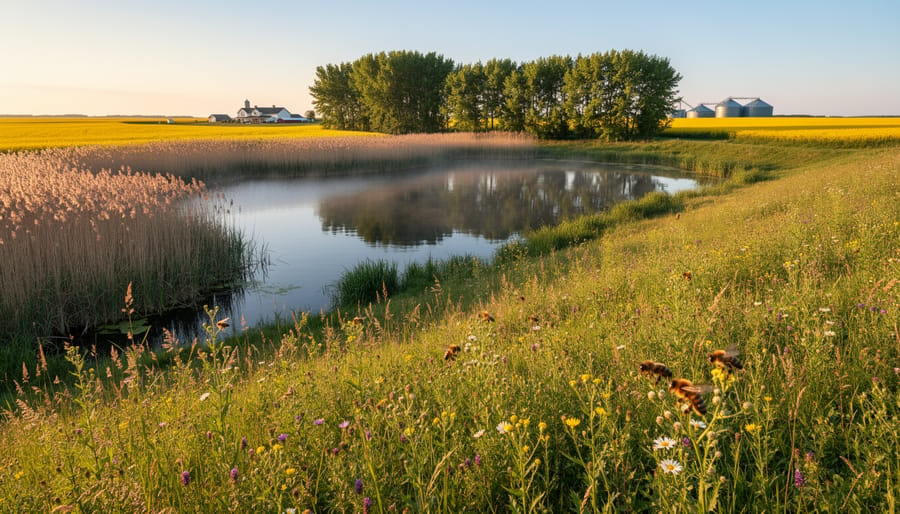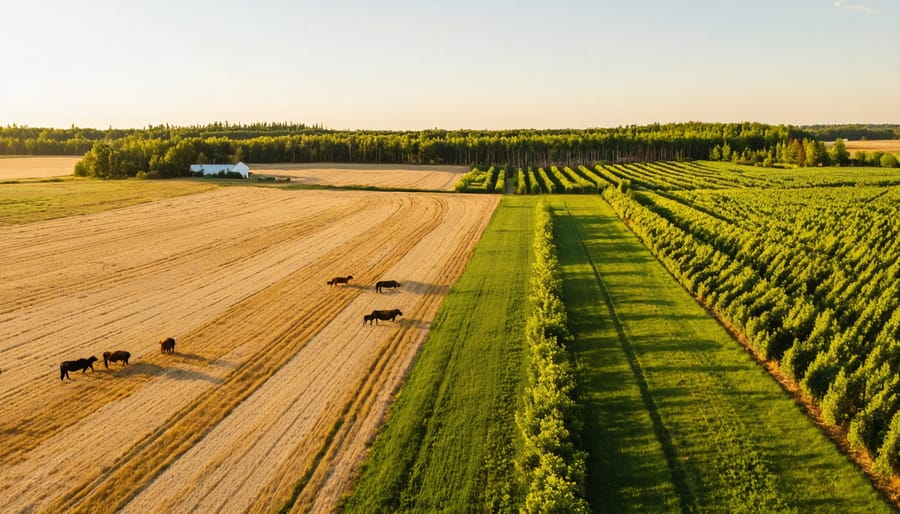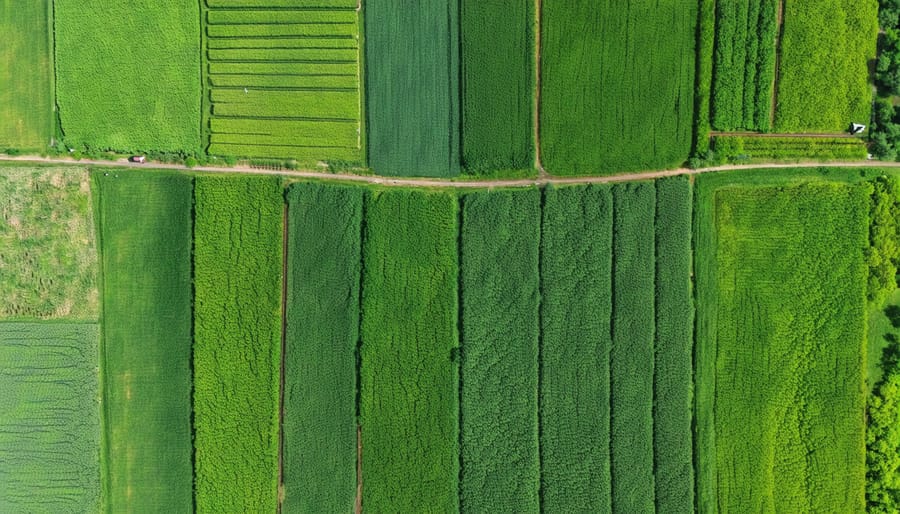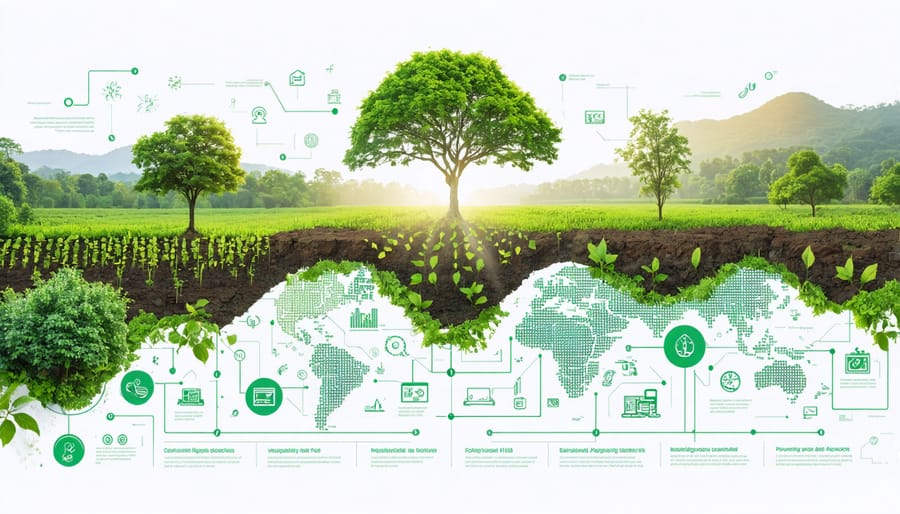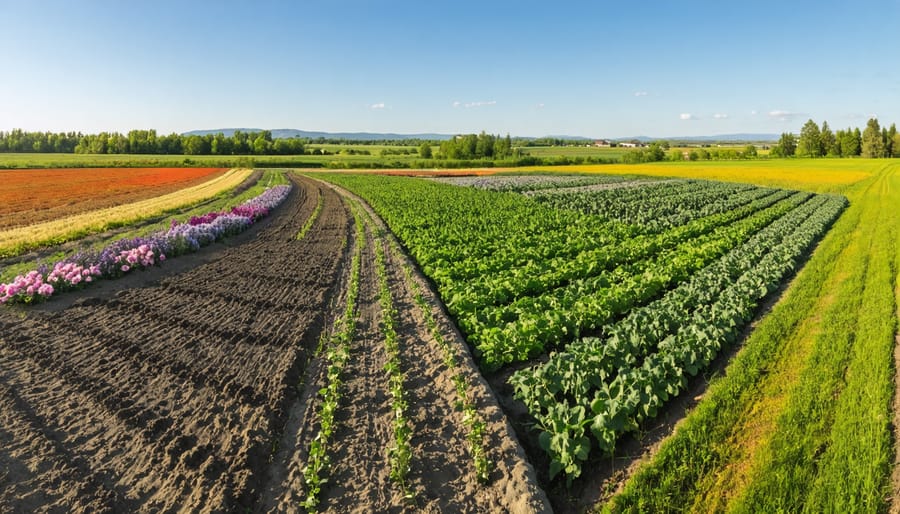Water resource economics shapes every decision on modern Canadian farms, transforming how we value and manage our most precious agricultural asset. From the sun-baked fields of Southern Alberta to the fertile valleys of the Peace Region, farmers face mounting pressure to maximize water efficiency while maintaining profitable operations. Through sustainable farming practices, producers are discovering innovative ways to balance economic viability with responsible water stewardship.
Recent data from Alberta Agriculture shows that farms implementing strategic water management systems see up to 30% reduction in water costs while maintaining or increasing crop yields. This economic advantage becomes increasingly critical as climate variability and water scarcity challenge traditional farming methods. Whether managing irrigated crops, livestock operations, or dryland farming, understanding the economics of water resources isn’t just about conservation—it’s about securing the future of Canadian agriculture.
By treating water as both a finite resource and an economic asset, farmers across the prairies are pioneering approaches that protect their bottom line while ensuring long-term sustainability for future generations. This practical guide explores proven strategies for optimizing water use efficiency while maximizing farm profitability in the Canadian agricultural context.
The True Cost of Water in Alberta Agriculture
Current Water Pricing Structure
In Alberta, water pricing follows a tiered structure that reflects both the value of the resource and the infrastructure costs associated with delivery. Irrigation districts typically charge a base rate of $15-20 per acre annually, which covers system maintenance and basic water allocation. Additional water usage beyond the base allocation incurs graduated fees, encouraging conservation while ensuring fair access for all users.
For agricultural operations, the pricing model includes both fixed and variable components. The fixed component covers infrastructure costs and administrative overhead, while the variable rate is based on actual water consumption, measured in cubic metres. Current rates average around $0.25 per cubic metre for agricultural use, though this can vary by region and season.
Local water cooperatives often implement block rate structures, where the first block (typically 0-15 cubic metres) is priced lower to ensure basic needs are met, while subsequent blocks see increasing rates. This system helps maintain equitable access while promoting efficient use.
Many irrigation districts also offer water trading programs, allowing farmers to transfer unused water allocations to other users within the same district. This market-based approach has proven effective in optimizing water distribution and creating economic incentives for conservation.

Hidden Costs and Long-term Impact
When we talk about water management on Canadian farms, it’s crucial to look beyond the immediate costs of irrigation systems and water access. Hidden expenses often emerge through increased soil salinity, which can reduce yields by up to 25% in affected areas across Alberta. Long-term infrastructure maintenance, particularly for aging irrigation systems, can add significant yearly costs that many farmers don’t initially factor into their budgets.
Environmental impacts also carry economic consequences. Changes in groundwater levels can affect neighbouring properties, potentially leading to community disputes and costly remediation efforts. Climate variability adds another layer of complexity, with drought periods requiring supplementary water sources that come at premium rates.
Looking ahead, investments in water-efficient technologies might seem steep initially, but local farmers who’ve made the switch report average savings of $75-100 per hectare annually after the third year. The Bow River Basin irrigation district demonstrates how collective water management can reduce individual farm costs while ensuring sustainable access for future generations.
Remember, water pricing structures are likely to change as resources become more constrained. Building resilient water management systems today can protect your farm’s economic viability for years to come. Consider joining local watershed management groups to stay informed about upcoming changes and funding opportunities.
Water-Smart Economics on Your Farm
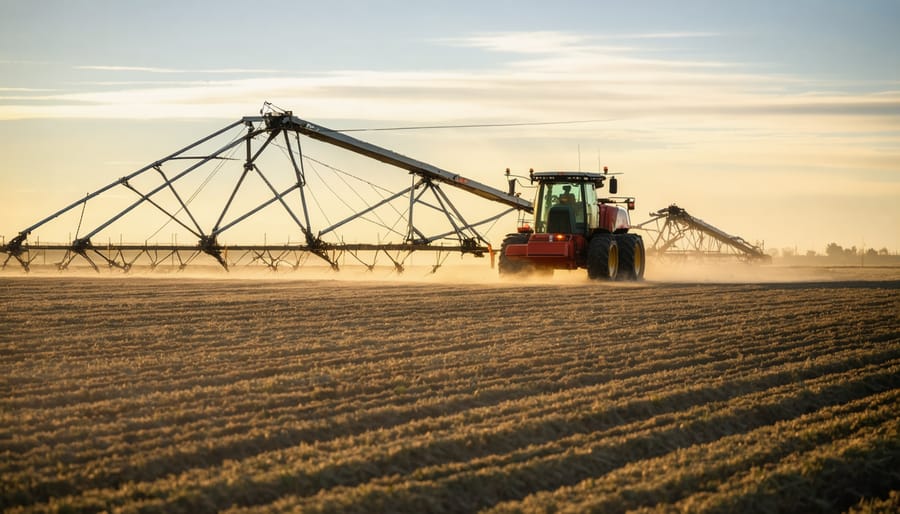
Efficient Irrigation Systems
Modern irrigation systems represent a significant investment, but their economic benefits often outweigh the initial costs for Alberta farmers. A recent study from the Lethbridge Research Centre shows that precision irrigation systems can reduce water usage by 30-40% while increasing crop yields by 15-25% compared to traditional flood irrigation methods.
For example, pivot irrigation systems, which cost approximately $1,500-2,000 per hectare to install, typically pay for themselves within 3-5 growing seasons through reduced labour costs and improved water efficiency. Local farmer Dave Thompson from Cardston County reports saving nearly $12,000 annually in water and energy costs after upgrading to a variable-rate irrigation system.
Drip irrigation systems, while more expensive at $2,500-3,000 per hectare, offer even greater water savings of up to 60% and are particularly effective for high-value crops like vegetables and berries. The Alberta Irrigation Technology Centre demonstrates that these systems can reduce fertilizer costs by 20-30% through precise nutrient delivery.
Smart irrigation controllers and soil moisture sensors, costing $500-1,500 per unit, provide additional savings by preventing over-irrigation and reducing pump operating hours. Many Alberta producers can access government grants and rebates through the Canadian Agricultural Partnership, covering up to 30% of irrigation upgrade costs, making the transition to efficient systems more affordable.
Water Storage Solutions
Investing in water storage solutions offers significant economic returns for Alberta farmers while promoting sustainable agricultural practices. Modern circular water management systems can reduce water costs by up to 40% annually, according to recent studies by Alberta Agriculture and Forestry.
Storage options like dugouts, retention ponds, and underground cisterns allow farmers to capture snow melt and rainfall during wet periods, providing crucial reserves during dry spells. A well-designed 1,000-cubic-metre dugout typically costs between $15,000 and $20,000 to construct but can save up to $5,000 annually in irrigation costs while providing emergency drought protection.
Water recycling systems are increasingly popular among greenhouse operators and intensive livestock operations. These systems can reclaim up to 75% of water used in operations, significantly reducing both water consumption and associated costs. For example, the Thompson Family Farm in Olds achieved a return on investment within three years after installing a comprehensive water recycling system.
Many farmers are also implementing rainwater harvesting systems on their buildings. A typical barn roof of 200 square metres can collect approximately 150,000 litres of water annually in Alberta’s climate, providing a reliable supplementary water source for livestock or greenhouse operations. Provincial grants and incentives often cover up to 30% of installation costs, making these systems increasingly accessible to farmers of all sizes.
Soil Management for Water Retention
Investing in regenerative soil management practices can significantly reduce irrigation costs while improving crop yields. For Alberta farmers, every 1% increase in organic matter can help soil retain an additional 27,000 litres of water per hectare. This enhanced water retention capacity translates to direct cost savings, with many local farmers reporting up to 30% reduction in irrigation expenses.
Studies from Southern Alberta demonstrate that farms implementing cover crops and minimal tillage practices save an average of $75-100 per hectare annually on water-related costs. These savings come from reduced pumping requirements, lower equipment maintenance, and decreased labour hours dedicated to irrigation management.
The economic benefits extend beyond water savings. Improved soil structure leads to better nutrient cycling, reducing fertilizer requirements by approximately 20%. Local farmer Sarah Thompson from Lethbridge County reports that after three years of implementing these practices, her farm’s water efficiency increased by 40%, while overall operational costs decreased by 25%.
By combining traditional knowledge with modern soil health principles, Alberta farmers are discovering that water conservation through soil management isn’t just environmentally responsible – it’s financially rewarding. The initial investment in soil improvement typically pays for itself within 2-3 growing seasons through reduced input costs and improved crop resilience during dry periods.

Success Stories: Alberta’s Water-Wise Farmers
Southern Alberta Grain Operation
In the heart of southern Alberta, the Henderson family farm demonstrates how effective water resource management can translate into sustainable economic success. Operating 2,000 hectares of wheat and canola, the Hendersons implemented a precision irrigation system in 2018 that reduced their water consumption by 30% while maintaining crop yields.
The farm’s irrigation system uses soil moisture sensors and weather monitoring equipment to optimize water delivery. This technology-driven approach costs approximately $275 per hectare to implement but generates annual water savings worth $180 per hectare. The initial investment was recovered within three growing seasons through reduced pumping costs and improved crop quality.
Local agricultural economist Sarah Martinez notes that the Henderson operation exemplifies the economic benefits of strategic water management: “Their success shows how modern irrigation practices can balance environmental stewardship with profitability. They’re using 40% less energy for pumping and have seen a 15% increase in grain quality.”
The farm participates in Alberta’s Water Stewardship Program, which provides rebates for water-efficient equipment installations. Through this initiative, they received $50,000 in grants, significantly offsetting their infrastructure costs. The Hendersons also share their water usage data with neighboring farms, contributing to a regional database that helps optimize irrigation practices across southern Alberta’s grain belt.
Their experience has become a model for other Prairie grain operations, demonstrating how water resource economics can drive both environmental and financial sustainability in Canadian agriculture.
Central Alberta Mixed Farm
The Henderson family farm, located 30 kilometers east of Red Deer, offers an inspiring example of effective water resource management in central Alberta’s mixed farming operations. Operating 640 hectares of land, the Hendersons combine crop production with a 200-head cattle operation, demonstrating how diversification and smart water management can work together.
In 2018, the farm implemented a comprehensive water management system that includes three dugouts, strategic wetland preservation, and efficient irrigation scheduling. The Hendersons invested $75,000 in water infrastructure, including moisture monitoring equipment and precision irrigation technology, which paid for itself within three years through reduced water consumption and improved yields.
Their rotation of canola, wheat, and barley is complemented by 160 hectares of permanent pasture, strategically positioned to protect natural water sources. The family maintains detailed records of water usage, showing a 30% reduction in irrigation needs since implementing their management plan.
“Water isn’t just about irrigation,” explains Sarah Henderson. “It’s about building resilience into your whole operation.” The farm’s approach includes collecting snowmelt in spring, maintaining grass buffer zones around water sources, and using drought-resistant crop varieties when possible.
The results speak for themselves: crop yields have increased by 15% while water costs have decreased by 25%. The Hendersons now share their experiences through local farming workshops, helping other producers develop their own water management strategies.
Future-Proofing Your Farm’s Water Economics
As Alberta’s climate continues to evolve, forward-thinking water management strategies are becoming essential for farm sustainability. The key to future-proofing your farm’s water economics lies in developing adaptable systems that can withstand both environmental and market changes while creating additional revenue streams.
Consider implementing smart irrigation technologies that can reduce water consumption by up to 30% while maintaining crop yields. These systems, though requiring initial investment, typically pay for themselves within 3-5 growing seasons through reduced water costs and improved crop quality.
Diversification of water sources is another crucial strategy. Many Alberta farmers are now incorporating water storage systems, including dugouts and retention ponds, which can capture spring runoff and heavy rainfall for use during drier periods. This approach not only provides water security but also helps manage costs during peak usage periods.
Water trading and sharing agreements are gaining traction among neighbouring farms. These arrangements can provide flexibility in water access while creating opportunities for cost-sharing and resource optimization. Some communities have established successful water-sharing cooperatives that have reduced individual farm water costs by 20-25%.
Investment in soil health is perhaps the most cost-effective long-term strategy. Healthy soils with high organic matter content can retain up to 190,000 litres more water per hectare than degraded soils. This improved water retention translates to reduced irrigation needs and lower operational costs.
Looking ahead, consider participating in watershed stewardship programs. These initiatives often provide funding for water-efficient infrastructure and can help offset the costs of implementing new water management systems. Many farmers are finding that their conservation efforts are opening doors to premium markets and environmental certification programs, adding value to their products.
Remember that future-proofing isn’t just about protecting against challenges – it’s about positioning your farm to thrive in changing conditions. By taking proactive steps today, you’re investing in your farm’s long-term economic resilience and environmental sustainability.
As we’ve explored throughout this article, effective water resource management is both an economic necessity and an opportunity for Alberta farmers. By implementing water-efficient irrigation systems, you can reduce costs while maintaining crop yields. Consider starting with a water audit of your farm operations and gradually upgrading to precision irrigation technology. Join local agricultural cooperatives to share resources and knowledge about water conservation practices. Remember that even small changes, like adjusting irrigation scheduling or selecting drought-resistant crops, can lead to significant savings over time. Take advantage of provincial water management programs and connect with agricultural extension services for support. Together, we can build a more sustainable and profitable farming future while preserving our precious water resources for generations to come. The success of Alberta’s agricultural community depends on each of us making informed decisions about water use today.


